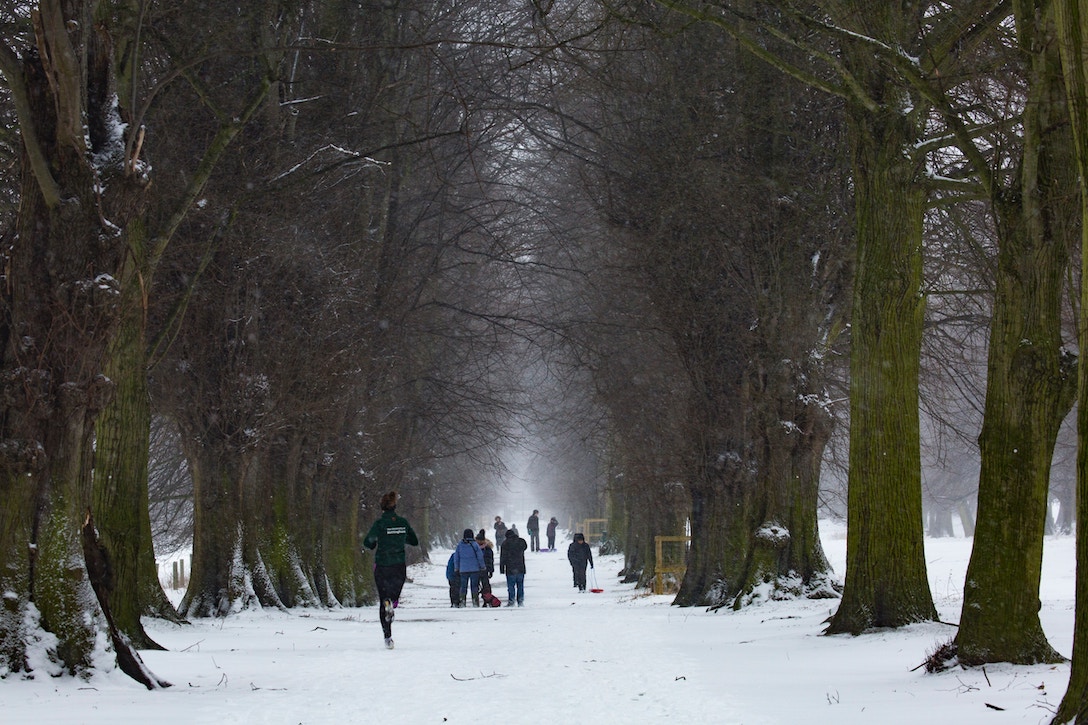
When exercising in low-temperatures you: 1) rely on carbohydrates more and less on fats for energy 2) your lactate production is higher for a given intensity, indicating that you’re going deeper into “oxygen debt” to produce the necessary energy to maintain a given pace (as evidenced by a high oxygen consumption rate in colder temperatures) and 3) your muscle contractions are less powerful, which demands an increase in fast-twitch muscle fibre usage, perhaps explaining the higher lactate production.
Relying more on carbohydrates will drain your energy reserves faster on long runs. Higher lactate production, and less efficient muscle contractions are also problematic for shorter races. These effects can be mitigated with warm clothing and moderate activity (like running) to maintain your body
Maintaining your carbohydrate and fluid intake levels are important, you’re more likely to “hit the wall” in training or in a long race during cold weather.
Dehydration is a risk in cold weather, as low temperatures increase urine output and diminish thirst. Water losses from breathing and sweating remain significant, even in cold temperatures, so staying hydrated should be a priority.
Breathing
Before reaching the lungs, the air we breathe must journey through a series of tubes that warm and humidify them. At rest, this task is accomplished quite easily in most people. However, during exercise, when breathing rates increase, the capacity of the “conducting airways” to warm and humidify the air is often exceeded. This allows unconditioned air to reach the small airways, causing them to become dehydrated and inflamed. In turn, they can sometimes constrict and produce mucous. Running in the cold can therefore cause a cough in susceptible people.
If repeated over a prolonged period, this mechanism of airway dehydration and inflammation can cause long-term injury to the respiratory system. People who are susceptible can develop a condition known as exercise-induced bronchoconstriction (EIB) which causes asthma-like symptoms (cough, wheeze, mucous production) during exercise.
If you have access to the facilities, you could do more training, or a portion of your long runs, indoor on the treadmill or a track. You could try wrapping a buff over your nose and mouth, as the microfibers will trap some of the warm and humid air you expire, allowing it to recirculate.
Clothing
Some of the performance drops associated with cold weather may be the result of having a higher baseline metabolic rate, which is one of the body’s mechanisms to maintaining core temperature. Shivering is a good example of this and this could “steal” energy that would otherwise be used for athletic performance.
It is critically important to keep your body warm at all times when exercising in the cold. Environments that are cold and wet are also problematic, as they dramatically increase heat loss and render many fabrics ineffective. It is important to stay warm before and during a workout or a race in the cold. It is much harder to bring it back up once it has dropped. Warming up before a race or workout becomes even more critical in the cold.
Layering is always a good idea in the cold, it is easier to calibrate your optimal clothing level when you have several thinner layers versus one thick one. If you’re going to train or race in cold weather frequently, it’s probably worth investing in some technical cold-weather clothing, especially if you encounter cold and wet conditions frequently. If you’re worried about having too many layers, choose a loop that circles back in front of your house and ditch layers if need be.
Wear running gloves, a hat, and a running buff or face covering for the cold. As with your running layers, if your accessories get too hot, you can take them off during the run and put them in your pockets.
Winter weather can change quickly and dramatically. Plan ahead for general winter weather such as running during the warmest parts of the day if possible, and also keep your eyes on the weather for any upcoming storms or deep temperature drops.
Be sure to change into warm, dry clothes as soon as possible after your run.
Buy shoes with good traction on the outsole with either Gore-Tex or water-resistant materials to keep your feet warm and dry. Some other gear to invest in is thermal or merino-wool moisture-wicking socks, a winter-specific hat, warm gloves that are not too bulky, plus a wind and water-resistant jacket to keep you warm and dry.
They have specific shoes for snow and ice. Trail shoes can also fit the bill. Other options are Yaktrax or putting small screws into the bottom of old shoes.
Look for a running jacket that isn’t black, and that has reflective elements is beneficial, so you can be seen by motorists. If you can’t get your mind off that stylish black jacket, there are plenty of reflective accessories (i.e., lights, vests, reflective bands and tape).
Other accessories to consider are hand/foot warmer packets and battery operated clothing.
Other tricks to stay warm are to start your run indoors on a treadmill before heading out doors or putting your clothes in the dryer before putting them on and heading out.
Last note – safety
Avoid roads or paths that have not been cleared of snow and ice, and instead, look for running routes that have been plowed and are well-lit, so drivers and other pedestrians can see you. If you’re running in the dark, invest in headlamps or other lighting options. Winter running is not ideal for speed work, and the weather may slow you down. It’s perfectly ok to run slower paces than usual as the main goal of winter running is to keep your base miles up and stay fit (and sane).